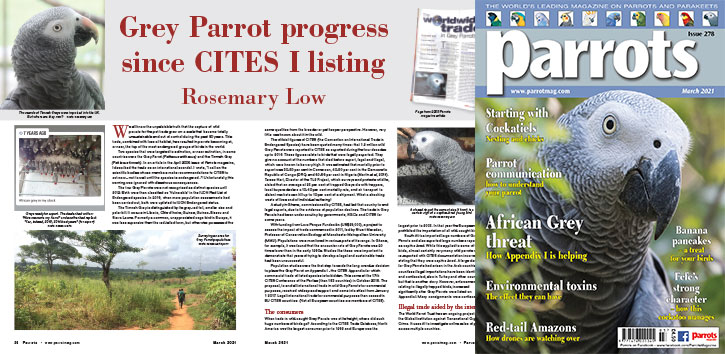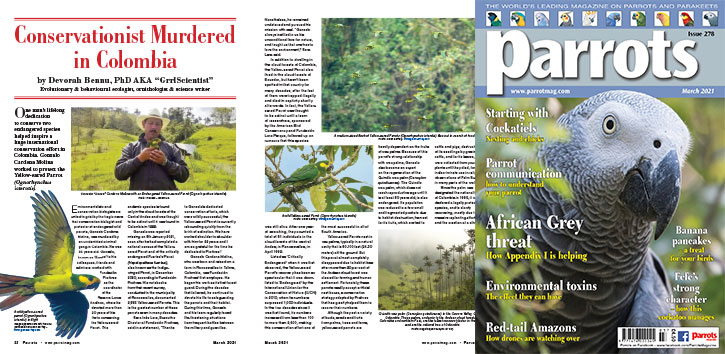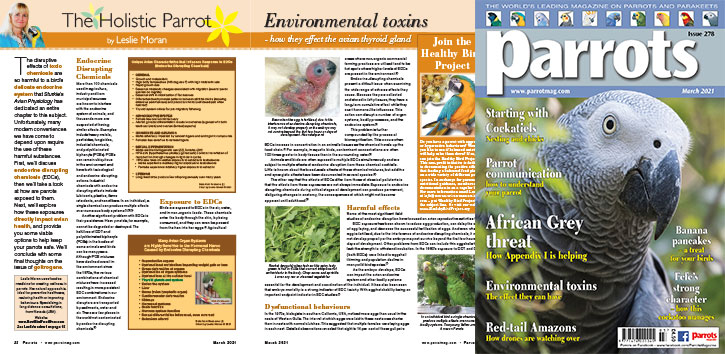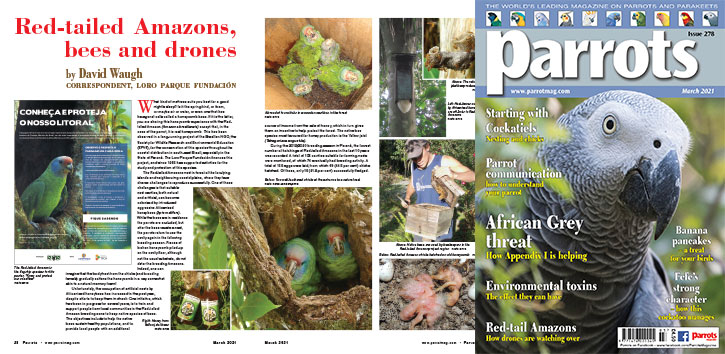
By Rosemary Low
We all know the unpalatable truth that the capture of wild parrots for the pet trade grew on a scale that became totally unsustainable and out of control during the past 50 years. This trade, combined with loss of habitat, has resulted in parrots becoming at, or near, the top of the most endangered groups of birds in the world.
Two species that were targeted to extinction, or near extinction, in some countries were the Grey Parrot (Psittacus erithacus) and the Timneh Grey (Psittacus timneh). In an article in the April 2005 issue of Parrots magazine, I described the trade as an international scandal. I wrote, “I call on the scientific bodies whose members make recommendations to CITES to act now – not to wait until the species is endangered...”. Unfortunately, this warning was ignored with disastrous consequences.
The two Grey Parrots were not recognised as distinct species until 2012. Both were then classified as ‘Vulnerable’ in the IUCN Red List of Endangered species. In 2016, when more population assessments had been carried out, both were uplisted to IUCN Endangered status.
The Timneh Grey is distinguished by its grey-red tail, smaller size and paler bill. It occurs in Liberia, Côte d’Ivoire, Guinea, Guinea-Bissau and Sierra Leone. Formerly a common, unappreciated cage bird in Europe, it was less expensive than the red-tailed form, but otherwise possessed the same qualities from the breeder or pet keeper perspective. However, very little was known about it in the wild.
Buy Now!

Devorah Bennu, PhD AKA “GrrlScientist”, Evolutionary & behavioural ecologist, ornithologist & science writer
One man’s lifelong dedication to conserve two endangered species helped inspire a huge international conservation effort in Colombia. Gonzalo Cardona Molina worked to protect the Yellow-eared Parrot (Ognorhynchus icterotis).
Environmentalists and conservation biologists are united in grief by the tragic news that conservation biologist and protector of endangered wild parrots, Gonzalo Cardona Molina, was murdered by an unidentified criminal gang in Colombia. He was 55 years old. Gonzalo, known as ‘Gonza’ to his colleagues, friends and admirers, worked with Fundación ProAves as the coordinator of the Reserva Loros Andinos, where he devoted more than 20 years of his life to conserving the Yellow-eared Parrot. This endemic species is found only in the cloud forests of the Central Andes and was thought to be extinct until it was found in Colombia in 1999.
Gonzalo was reported missing on 8th January 2021, soon after he had completed a national census of the Yellow-eared Parrot and of the critically endangered Fuertes’s Parrot (Hapalopsittaca fuertesi), also known as the Indigo-winged Parrot, in December 2020, according to Fundación ProAves. His notebooks from that recent survey, conducted in the municipality of Roncesvalles, documented 2,895 Yellow-eared Parrots. This is the greatest number of these parrots seen in many decades.
Buy Now!

The Holistic Parrot by Leslie Moran
The disruptive effects of toxic chemicals are so harmful to a bird’s delicate endocrine system that Sturkie’s Avian Physiology has dedicated an entire chapter to this subject. Unfortunately, many modern conveniences we have come to depend upon require the use of these harmful substances. First, we’ll discuss endocrine disrupting chemicals (EDCs), then we’ll take a look at how are parrots exposed to them. Next, we’ll explore how these exposures directly impact avian health, and provide you some viable options to help keep your parrots safe. We’ll conclude with some final thoughts on the issue of goitrogens.
More than 100 chemicals used in agriculture, industry and from municipal sources are known to interfere with the endocrine system of animals, and thousands more are suspected of having similar effects. Examples include heavy metals, pesticides, fungicides, industrial chemicals, and polychlorinated biphenyls (PCBs). PCBs can remain ubiquitous in the environment and have both toxicological and endocrine disrupting actions. Industrial chemicals with endocrine disrupting effects include lubricants, plastics, flame retardants, and nanofibers. In an individual, a single chemical can produce multiple effects over numerous body systems.
Another significant problem with EDCs is their persistence. Heavy metals, for example, cannot be degraded or destroyed. The half-lives of DDT and polychlorinated biphenyls (PCBs) in the bodies of some animals and birds can be many years. Although PCB mixtures have declined overall in the environment since the 1970s, the various combinations of chemical mixtures have increased resulting in more persistent EDC combinations in our environment. Endocrine disruptors are transported by sediments, water and air. There are few places in the world not contaminated by endocrine disrupting chemicals.
Buy Now!

David Waugh, Correspondent, Loro Parque Fundación
What kind of mattress suits you best for a good night’s sleep? Is it the spring kind, or foam, or maybe air or water, or even one that has hexagonal cells called a honeycomb base. If it is the latter, you are sharing this honeycomb experience with the Red-tailed Amazon (Amazona brasiliensis) except that, in the case of the parrot, it is real honeycomb. This has been observed in a long-running project of the Brazilian NGO, the Society for Wildlife Research and Environmental Education (SPVS), for the conservation of this species throughout its coastal distribution in south-east Brazil, especially in the State of Paraná. The Loro Parque Fundación finances this project, and since 1995 has supported activities for the study and protection of this species.
The Red-tailed Amazons nest in forest of the low-lying islands and neighbouring coastal plains, where they face diverse challenges to reproduce successfully. One of those challenges is that suitable nest cavities, both natural and artificial, can become colonised by introduced aggressive Africanized honeybees (Apis mellifera). While the bees are in residence the parrots are excluded, but after the bees vacate a nest, the parrots return to use the cavity again in the following breeding season. Pieces of broken honeycomb piled-up on the cavity floor, although not the usual substrate, do not deter the breeding Amazons. Indeed, one can imagine that the body heat from the chicks (and brooding female) gradually softens the honeycomb in a way somewhat akin to a natural memory foam!
Buy Now!




